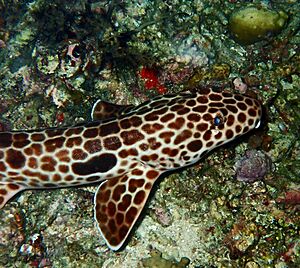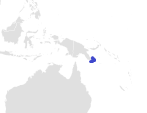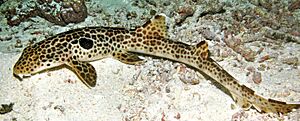Leopard epaulette shark facts for kids
Quick facts for kids Leopard epaulette shark |
|
|---|---|
 |
|
| Conservation status | |
| Scientific classification | |
| Genus: |
Hemiscyllium
|
| Species: |
michaeli
|
 |
|
| Known range of the leopard epaulette shark (in blue) | |
The leopard epaulette shark (Hemiscyllium michaeli) is a super cool type of bamboo shark. It's also sometimes called the Milne Bay epaulette shark or Michael's epaulette shark. This amazing shark lives in the warm, shallow waters around Milne Bay in eastern Papua New Guinea. For a long time, people thought it was the same as another shark, the Indonesian speckled carpetshark. But in 2010, scientists Gerald R. Allen and Christine L. Dudgeon discovered it was its own special species! This shark can grow up to about 82 centimeters (32 inches) long.
Contents
Why is it Called That?
The leopard epaulette shark was first mistaken for another shark species. But a photographer and aquarium expert named Scott W. Michael noticed they were different. He told researchers about it.
Because of his help and the photos he shared, the shark was named in his honor. That's why it's called "Michael's epaulette shark"! Another common name is the Milne Bay epaulette shark, named after the area where it lives.
Where Does This Shark Live?
The leopard epaulette shark only lives in eastern Papua New Guinea. Most of the time, people see them in the Milne Bay area. They have also been found near Harvey Bay in Oro Province.
Scientists are still learning if these sharks live further along the Papua New Guinea coast. They also want to know where their home territory meets that of the Papuan epaulette shark.
Shark Homes in the Ocean
These sharks like shallow water, usually less than 20 meters (66 feet) deep. You can find them in warm, tropical places like coral reefs and rocky areas. They also hang out in tidal pools and seagrass beds.
What Does This Shark Look Like?
The leopard epaulette shark has a long, slender body. More than half of its body is its thin tail! Its back fin (dorsal fin) and bottom fin (anal fin) are set very far back on its super long, thick tail. It looks a bit different from other Hemiscyllium sharks because its first dorsal fin and anal fin are shorter.
Unique Markings
This shark is famous for its special color pattern. It has lots of dark, leopard-like spots all over its body. It also has a big, black, eye-like spot behind its head. This spot has a white rim around it.
The shark's body is usually whitish to light gray-brown. It has a thick network of brown spots on its head, body, and fins. Sometimes, you can faintly see about 9 to 10 bars on its sides, which are clearer on its tail. The dorsal fins have 2 to 3 saddle-like markings along their edges.
Young Sharks Look Different
Younger leopard epaulette sharks don't have the leopard-like spots. Instead, they have solid spots on their head, body, and fins. Baby sharks are mostly white with several dark brown bars. They also have a few small brown spots on their head and front body. Even as babies, they still have the distinct large eye-like spot.
Snout and Teeth
The shark has a short, rounded snout. Its nostrils are almost at the very tip, with two tiny whiskers (barbels) nearby. There are grooves running from its nostrils to its mouth. This shark has many rows of small teeth, with broad bases and pointy tips.
Leopard epaulette sharks are usually about 60 to 78 centimeters (23.6 to 30.7 inches) long. The longest one ever reported was at least 82 centimeters (32.3 inches).
How This Shark Lives
This shark is amazing because it can "walk"! Like other Hemiscyllium sharks, it moves by bending its body from side to side. It pushes off the ground with its paddle-shaped pectoral and pelvic fins. This helps it move around its complex reef home.
Walking Like a Salamander
Its walking style is similar to how salamanders move. This is a cool example of convergent evolution, where different animals develop similar traits. The shark can swim, but it often prefers to walk along the sandy or coral bottom.
The special bones in the shark's paired fins are flexible. This allows them to rotate and be used like legs. This unique way of moving even lets the shark crawl out of the water! It can reach isolated tidal pools this way. Scientists think this walking ability might have helped land animals evolve.
Night Life and Resting
Leopard epaulette sharks are mostly active at night. They often hide inside or under coral heads. Sometimes, they just cover their head, leaving the rest of their body exposed. They might also rest in the open on sandy areas or on top of reefs, facing the current. This helps them breathe better or notice predators.
Walking Shark on TV
The first time a leopard epaulette shark was filmed walking out of the water was by wildlife biologist Forrest Galante. This amazing footage was shown in a documentary called Island of the Walking Sharks during Shark Week 2022. It was the first time one of the Papuan epaulette species was filmed walking on land!
Human Interactions
Leopard epaulette sharks are harmless to humans. If you handle them, they might nip you, but they are not dangerous.
Because they live in a small area, their homes are sometimes damaged. They are also sometimes caught for food by local fishermen. It's possible they could also be caught for the aquarium trade.



